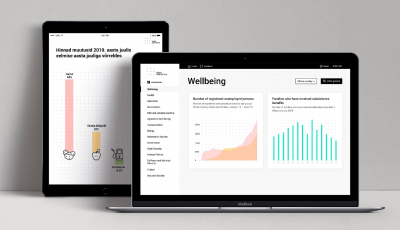Executive summary
In the latter half of 2023, we launched two new solutions that form an integral part of the self-service portal of the Social Insurance Board (SKAIS), one of Estonia’s biggest public IT systems. The new solutions allow Estonian residents to conveniently apply to determine the severity of their disability and request related social benefits. At the same time, the Social Insurance Board staff and medical experts can process the applications more efficiently and allocate support faster.
The introduction of these two new solutions has simplified the application process for children and people of retirement age, who can now conveniently submit their applications online, which was previously not possible. Moreover, the new solutions incorporate the International Classification of Functioning, Disability and Health (ICF), a WHO classification of health and health-related domains, into the process.
The solution implemented for the staff and medical experts optimizes workflow and reduces workload thanks to built-in checks and streamlined processes. As a result, people can receive decisions and support more quickly. The project is expected to positively impact a large part of the population, including more than 75,000 children and retirees, as well as 45,000 working-age individuals.
The modern tech stack and restructuring of the system as a microservice, rather than a monolith platform, leads to lower maintenance costs and easier modifications in the future.
The project offered a significant technical challenge in designing the architecture for complex services from scratch while minimizing disruption for users. Building a system with a large societal impact was a deeply rewarding experience for the team. You can learn more about the project and its benefits from the case study.
Meet the customer
The Health and Welfare Information Systems Centre (TEHIK) is responsible for managing IT projects on behalf of the Social Insurance Board, which is a government institution that provides social safety net services for people in Estonia. One of the country’s most important public IT systems is the self-service portal of the Social Insurance Board (SKAIS), which allows Estonian residents to easily manage social support services and available benefits, such as family allowances and pensions. The portal is designed to cater to people at different stages in their lives.
In 2021, TEHIK initiated a procurement process to develop new services for SKAIS to determine the severity of disability and allocate related benefits. SKAIS selected Helmes to create the solution, launching it successfully in the second half of 2023.
The challenge
The Social Insurance Board sought to simplify the application process with the new services by offering people a convenient e-service and to streamline the processing so that people would receive support more quickly. Two distinct services were required, since the application process for children and those of retirement age differ.
The first service would introduce a self-service option for more than 75,000 people, who previously could not submit their applications online but could only fill in applications on paper or in a file format and submit them to the Social Insurance Board by mail, email or in person. The second system was targeted at approximately 45,000 working-age individuals, the majority of whom submit their applications through the Unemployment Insurance Board.
The crucial aspect is the involvement of medical experts in assessing the severity of disability . An important requirement for the new systems was to incorporate the International Classification of Functioning, Disability and Health (ICF), which is a WHO classification of health and health-related domains, in the evaluation process.
The solution
How does it work?
The new services integrate into the Social Insurance Board Information System (SKAIS), which consists of two applications: a self-service platform used by applicants and a platform used by the Social Insurance Board staff and medical experts (doctors).
One application has four stages:
The applicant fills in and submits the application.
For the first time, the new solution allows children and people of retirement age to submit their applications online. Previously, they could only do so on paper or in a file format.
A staff member checks the application and requests additional information if required.
The new solution automates the checks. If all necessary details are provided, Step 2 is skipped and the application goes straight to the medical expert.
A medical expert assesses the person’s health condition.
The final assessment is based on the applicant’s self-assessment and medical records received from the Estonian Health Information System. The new solution introduces the international classification of health and health-related domains (IFC) into the process for all three applicant groups.
A staff member makes the decision based on the assessment of the medical expert.
The new solution streamlines the application process by eliminating duplicate actions and unnecessary communication between a staff and doctors, ultimately resulting in faster decisions.
Technological framework
The tech stack used in the project was largely based on the existing SKAIS framework. One signficant technical improvement was the seperation of medical expertise as a microservice from the monolith system. As a result, the system is more modular and can be modified more easily in the future if necessary.
The new solutions are seamlessly integrated into the SKAIS platform, and connected with a large number of external systems such as the Unemployment Insurance Fund IT system, the Estonian Health Information System, and even a public transportation ticketing platform.
The development process
We began with a preliminary analysis of the Social Insurance Board’s ideal user journey. We provided a detailed description of each feature along with a time and cost estimate for the detailed analysis, development and testing stages. Furthermore, we also created a prototype of the future solution.
After that, we conducted an in-depth analysis of the functionality. We started the development process once the first segments of the system were analyzed. We followed an agile approach and held weekly meetings with the client, where we discussed the completed work and next steps.
During the development process, we maintained the old system used for determining the severity of disability, fixing issues that needed immediate attention. This gave us valuable insights we incorporated into developing the new system, thus avoiding any potential pitfalls.
The team
During peak times, there were 14 people working on the project, including a team lead, three analysts, eight developers and two testers. We worked closely with the product owner and project lead from TEHIK, as well as the staff responsible for disability-related services at the Social Insurance Board. This included advisors, case handlers, specialists and medical experts.
The project was a unique challenge for the team as we had to design complex services from scratch. Moreover, we had to extract a complicated business process from a monolithic system while ensuring the users had the impression that the application process had not changed. Despite the challenges, it was a deeply rewarding experience for team members to be able to contribute to a project that had a positive impact on a large number of citizens.
Benefits
The new solution provides a number of benefits for the users and staff of the Social Insurance Board:
- A new self-service option – Children and people of retirement age can now conveniently submit applications online
- Automated checks and notifications – For instance, the system verifies that the person has a legal place of residence in Estonia and is entitled to apply for benefits.
- Reducing workload – Thanks to built-in verifications, applications will automatically move to the stage of analysis by experts.
- Optimizing workflow – The system automatically assigns the applications to the medical expert who can respond fastest based on their workload and work schedule.
- Minimizing manual errors – The online applications minimize errors from manual data entry.
- Improved user experience – Users benefit from a smooth user experience, where they do not have to switch back and forth between different systems, and improved look and feel of the user interface.
- Minimal disruption for users – The application process remained the same for the users, although the system was completely rebuilt in the background.
- Future-proofing the system – Extracting the medical expertise from a monolith system makes it considerably easier to implement any future modifications.
- Optimized maintenance – Future maintenance requires less manual intervention, leading to considerable savings for the client.
The Social Insurance Board faced a major challenge in implementing a self-service solution based on the international classification of functional capacity for children and elderly pensioners, which required recognition of the severity of disabilities. Helmes provided invaluable IT development support in helping us achieve our goals. As our IT partner, Helmes fully understood the project’s complexity, importance, and our expectations. They made a substantial contribution to enhancing services for people with disabilities, thanks to their high-level team.
Kalev Härk, Social Insurance Board
Work with Helmes
If you are seeking an experienced custom development services provider for complex IT systems for the public and medical sector, please contact us.
Get in touch






